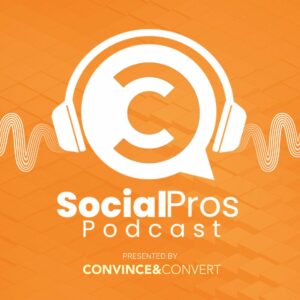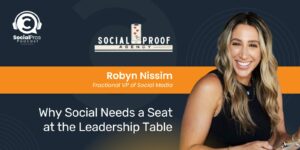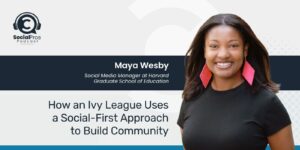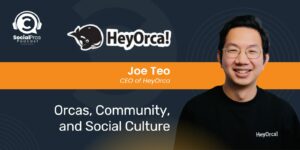Hosted By
About Social Pros Podcast:
Social Pros is one of the longest-running marketing podcasts in existence (10 YEARS and counting), and was recently recognized as the #1 Audio/Podcast Series by the Content Marketing Awards.
Our purpose? Making sure that we speak to real people doing real work in social media.
Listeners get inside stories and behind-the-scenes secrets about how teams at companies like Google, Reddit, Glossier, Zillow, Lyft, Marvel, and dozens more, staff, operate, and measure their social media programs. With 600+ episodes, the Social Pros Podcast brings the humanity of social media to the forefront, while providing incredibly useful marketing strategies that listeners can immediately implement.
Follow Social Pros on LinkedIn.
To inquire about becoming a guest or show sponsor, please email our Executive Producer, Leanna Pham, at leanna@convinceandconvert.com.
Apple Podcast Reviews:
The Social Pros podcast has quickly become a favorite in my feed! I'm consistently impressed by the engaging conversations, insightful content, and actionable ideas. I truly learn something every time I listen!
@Arlie KThis is absolutely an awesome listen for anyone in communications or social media!!
@Will31CThis podcast has become one of my staple weekly podcasts for learning about marketing! Love the conversations that they have and it's always enjoyable and educational!
@Simonstone95Love the podcast - informative, in depth and spot on for any business size.
@MissTriathlon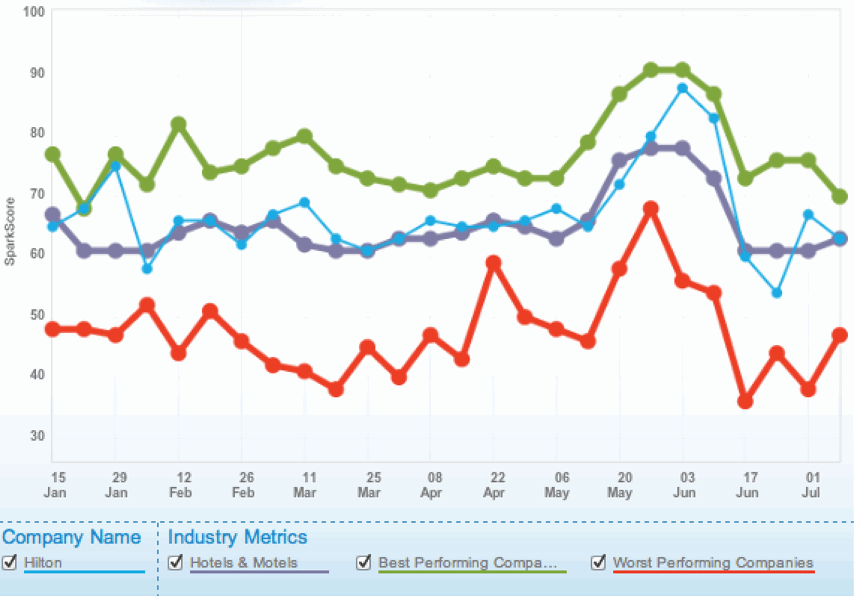
This is Episode 26 of the Social Pros Podcast : Real People Doing Real Work in Social Media. This episode features Richard Owen of Satmetrix. Read on for insights from Jay Baer & Eric Boggs‘s Social Media Stat of the Week (This week: The Altimeter Group released the public report, The Social Media ROI Cookbook. It’s six ingredients, top brands used to measure the […]
 This is Episode 26 of the Social Pros Podcast : Real People Doing Real Work in Social Media. This episode features Richard Owen of Satmetrix. Read on for insights from Jay Baer & Eric Boggs‘s Social Media Stat of the Week (This week: The Altimeter Group released the public report, The Social Media ROI Cookbook. It’s six ingredients, top brands used to measure the revenue impact of social media.)
This is Episode 26 of the Social Pros Podcast : Real People Doing Real Work in Social Media. This episode features Richard Owen of Satmetrix. Read on for insights from Jay Baer & Eric Boggs‘s Social Media Stat of the Week (This week: The Altimeter Group released the public report, The Social Media ROI Cookbook. It’s six ingredients, top brands used to measure the revenue impact of social media.)
Listen Now
Click the play button to listen here:
[podcast]http://socialpros.podbean.com/mf/web/fatsmv/SocialProsEpisode26.mp3[/podcast]
Download the audio file:
The RSS feed is: http://feeds.feedburner.com/socialprospodcast
Find us on iTunes: http://itunes.apple.com/us/podcast/convince-convert-blog-social/id499844469
Please Support Our Sponsors
Huge thanks to data-driven social media management software company Argyle Social for their presenting sponsorship, as well as Infusionsoft, Janrain, and Jim Kukral at DigitalBookLaunch. We use Argyle Social for our social engagement; we use Infusionsoft for our email; Janrain is our crackerjack social integration company, and Jim is our guest host for the podcast (and a smart guy).
Social Pros Transcript For Your Reading Enjoyment, Thanks to Speechpad for the Transcription
![]()
Jay: Welcome everybody to Social Pros. It is I, Jay Baer, back in the saddle, for Episode 26, or seven, something like that. Joined as always by my pal, the CEO of Argyle Social, data driven social media management software impresario, Eric Boggs.
Eric: That was a great introduction, Jay. You should always introduce me that way.
Jay: We could record it and that way we could always, because I couldn’t do it again in a row. But we’ll try it.
Eric: It’s good to have you back, man.
Jay: Thanks.
Eric: Jim Kukral and DJ Waldow did a fine job filling in, in your absence. But it’s definitely not the same without you leading the show. So, glad to have you back on the call.
Jay: Thank you very much, glad to back. I picked up a nasty cold when I was gone for last Monday’s show unfortunately, but I’m pressing through with the help of a crowdsourced regiment from Facebook. I asked everybody, “What to do for a sinus infection?” I got like 22 replies and sent my wife to the pharmacy with the printed out Facebook comments.
Eric: That’s interesting.
Jay: It’s post-modern healthcare, is what it is really.
Eric: That might be their new business model. I mean, they’re going to be doing the first earnings report this week. Maybe that could be a new line of business for them.
Jay: I like it, I like it. We should also take a moment to thank our other sponsors of the show. Not only Eric’s company Argyle Social, but our friends at Infusionsoft. Enterprise a CRM and email for businesses of all shapes and sizes, including our own. As mentioned, Jim Kukral, at Digitalbooklaunch.com, and the smarty-pants who’s out of Portland, Janrain. Social sign-in and tying your database of real people to the database of social media people, which is an interesting and important thing that we’re going to talk about a little bit more here on today’s podcast. Today’s very special guest – I’m super psyched about this show. We have Richard Owen, who’s the president and CEO of Satmetrix, the guys behind Net Promoter Score. They have a brand new thing called Spark Score, which actually lays social media chatter around the Net Promoter principles. I’m a big fan of all that jazz, so I’m delighted to have Richard on the show today.
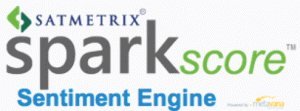 I’m going to give you my rant. As I mentioned, I’ve been gone for a while. I was on vacation. I was on “real” vacation for a while, for a couple of weeks in Greece and Spain with some friends and the family, and did all that and it was awesome. We were on a multitude of airlines during that trip. One of the airlines we were on, I won’t name them, but they are the official airline of a country that borders ours to the north. I’ve been on that airline a few times, because we do a fair amount of work in Canada, and I speak up there a lot. I’ve always had good experiences, and this was an international flight. They had the single surliest flight attendant I have ever encountered on any airline, across this great globe of ours. My son asked for a Sprite, and this lady said, “What is that, like five Sprites?” My daughter asked, “What is in the vegetarian lasagna?” She’s like, “Well, there’s no meat in there, so just eat it.” I mean, it was full-on, completely beyond the pale attitude. Everybody has a bad day, although since this flight was many, many hours, maybe it’s two bad days.
I’m going to give you my rant. As I mentioned, I’ve been gone for a while. I was on vacation. I was on “real” vacation for a while, for a couple of weeks in Greece and Spain with some friends and the family, and did all that and it was awesome. We were on a multitude of airlines during that trip. One of the airlines we were on, I won’t name them, but they are the official airline of a country that borders ours to the north. I’ve been on that airline a few times, because we do a fair amount of work in Canada, and I speak up there a lot. I’ve always had good experiences, and this was an international flight. They had the single surliest flight attendant I have ever encountered on any airline, across this great globe of ours. My son asked for a Sprite, and this lady said, “What is that, like five Sprites?” My daughter asked, “What is in the vegetarian lasagna?” She’s like, “Well, there’s no meat in there, so just eat it.” I mean, it was full-on, completely beyond the pale attitude. Everybody has a bad day, although since this flight was many, many hours, maybe it’s two bad days.
But it got me to thinking. We are in the process right now at Convince & Convert of doing some company activation programs in social. We’re taking social and moving it beyond marketing, and getting lots of people involved. Sales and engineering, and customer service, and those kind of programs. We talked about that in The Now Revolution, etc. So, we love that kind of work, but it got me thinking, jeez, now we’re going to take these people, who work for Company X or Company Y, and we’re going to say, “Not only do we want to deal with your day-to-day proclivities and shortcomings, but we want to magnify that by putting you in a real-time environment like social media.” It just makes me think that maybe I’ve got it all wrong. That I’ve been preaching this for three years, and maybe I’m totally wrong. That maybe we shouldn’t arm everybody in social, because if you get one flight attendant like that, and then put her on Twitter, the brand equity of that company is right down the tubes.
Eric: Well, my first reaction is, I’m surprised all flight attendants aren’t like that.
Jay: Yeah, that’s a tough gig. Yeah, I know that, yeah, exactly.
Eric: It’s a thankless job.
Jay: It is.
Eric: I think maybe surly, or maybe honest. Maybe every flight attendant is actually thinking that. That sounds funny and unpleasant. To, I think you are, I don’t know. It’s one of those things where, there are always two sides to that coin in terms of activating social advocates internally and externally. Because you’re right, you’re kind of giving these people a hot mic, and any slip up is going to reflect negatively, potentially on the entire organization. But you know, there are probably some safeguards around that. There’s probably some technology that you could roll out around that, that suggests content or provides some sort of guidelines. Or some sort of queuing mechanism, such that any brand related has to go through some sort of filter.
Jay: Yeah.
Eric: I don’t know. There’s a middle ground between…
Jay: Yep.
Eric: Zero and infinity.
Jay: Free reign, exactly.
Eric: In terms of access.
Jay: Yeah. Clearly, when we do that kind of training, there are lots of best practices and role playing and, “Do this. Don’t do that.” But in the heat of the moment, people do silly things, and we see that on Twitter in particular, every single day.
Eric: Yeah.
Jay: But there is some software coming to address that problem. In fact, I’m an adviser and an investor in a company that is going to start building some software to help that process of activating employees across an enterprise environment and having some measure of command and control. Not so much that nobody wants to participate, but just a little bit of a check and balance to make sure that people don’t basically jump off the pier.
Eric: Cool. I won’t say the name of the company, but it’s probably the same company I have in mind, and we should have that guy as a guest on the show.
Jay: We should have that guy as a guest on the show, absolutely.
Eric: Do you know of any instances off the top of your head, where you have seen this done well, where rank-and-file employee interacts with you on behalf of the brand, in a way that it creates a meaningful, positive experience?
Jay: It’s somewhat paradoxical. I think distributed social works better long-form than short-form. If you think about the number of companies that have thousands of bloggers, Dell and Intel will bubble up for many people in that regard. They seem to have very few issues there, if any. I think where you get stickier is the more real-time the circumstance, the more potential trouble that you’re in. The companies that have work flow really well established, are the companies that I think handle that successfully. Radian6, I think, really pioneered that model internally and had really specific, amazing ways of triaging and handling inquiries. I mean, you look at even something like Comcast Cares back in the day and Coca Cola, and there are a lot of other enterprise companies that have lots and lots of people active on Twitter. So, it’s not necessarily a recipe for disaster.
Eric: Yeah.
Jay: I just think, as you said, it’s a hot stove, and I don’t think there’s anything you can really do to make social media less hot, other than just say, “We’re not going to get involved.”
Eric: Yeah. Hmm.
Jay: So, on that cheery note, do you have for us, I know you’ve been missing this for a couple of weeks, do you have for us a Social Media Stat of the Week?
Social Media Stat of the Week: 56% of Execs Say Biggest Challenge is Tying Social to Business Outcomes
Eric: I do indeed. Now that you’re back in the saddle, it gets me back in the groove to actually have to think of one of these stats.
Jay: Yeah. When I’m not here, you guys should have just free-styled, right? There’s no show format. No sponsors get thanked. It’s just like a…
Eric: Hey. No, no, no, no, no.
Jay: I know. I’m kidding. You guys do that.
Eric: Hey, man. Hey, man.
Jay: You guys do that.
Eric: We do skip the stat of the week, though. It’s all that I can do to keep my thoughts organized and keep the show moving forward. To do that and do a stat of the week is…
Jay: I know.
Eric: It’s just too much to ask.
Jay: Too much, too much.
Eric: But I’ve got a good one this week. The good folks at Altimeter Group, specifically Susan Etlinger and Andrew Jones, put together a report. I’ve got a pre-release version. By the time this recording is mixed down and published, it will be a public report, The Social Media ROI Cookbook. It’s six ingredients, top brands used to measure the revenue impact of social media. Which if you’ve been a long-time listener of Social Pros, you will probably recognize that the revenue impact of social media is one of my favorite things in the word to talk about, as is Jay’s. It’s a great report. I suggest that you check it out. The data point that jumped out to me is from a survey they did from 71 social pros, actually. I should actually check, probably some people that have been guests on this podcast, were part of this survey.
Jay: We need to trademark that before it gets too late.
Eric: Social Pros, I know it. 56% of the 71 people surveyed cited, as their biggest challenge, the inability to tie their social media programs to business outcomes. Here we are in year, I don’t know, whatever, of social media and social media marketing, and it strikes me that that’s still a significant challenge. But I guess in some respects it’s not surprising at all because it’s still difficult for people to tie email marketing and search marketing, and other things that…
Jay: Yeah. Or radio for that matter.
Eric: Yeah.
Jay: Or billboards. It’s not that it’s inherently more difficult. In fact, I find it actually in some ways easier to do social media calculations than it is offline things, because you actually have a consistent data stream. It’s not that it’s inherently more difficult. It’s just a lot of work.
Eric: Yeah.
Jay: What I always say is, it’s not so much is ROI calculable, it’s what is the ROI of calculating ROI. Because that’s time that comes out of somebody’s time budget.
Eric: Yeah, indeed. It’s money budget that comes out of somebody’s money budget too, because it often requires some sort of external resource or software to do that. You nailed it too. I think that something we find with some of our customers, and just the market in general, is that people do get kind of hung up on problems that maybe don’t have that big of a payoff, when you do end up finding the solution. I think for very large organizations, there’s an obvious need to tie social to revenue, as long as that’s sort of metered by the size of the investment. For small companies, it may seem like sacrilege for me to say that. But for a lot of really, really small companies, put forth the effort to have a good presence and that might be as far as you need to take it.
Jay: Or the results may be self-evident. I mean, it may be anecdotally self-evident, and sometimes that’s okay.
Eric: Yeah.
Jay: Sometimes that’s enough. Or we’re big proponents of correlation studies as well, right? That if you pay attention to all the things that you’re doing. Not just social, but you pay attention to everything and you look for simultaneous lifts, then maybe the thing that you changed was the driver of those lifts.
Eric: Yeah, and I’ll tell you one of the more interesting things in this report was they listed six ingredients, which are basically tracking methodologies to track revenue. Ingredient number one is “anecdotal”.
Jay: There you go.
Eric: For suggested vendors it says, “You can do this for free without a vendor.” A lot of the others, there vendors listed and software providers. Let me actually scroll down in the report. For anecdotal, yeah, it just says you can use anecdotes from any and all social media service products.
Jay: There you go, that will work.
Eric: Yeah. This is from Altimeter Group, one of the sort of hotshot analyst firms, that work with some of the biggest companies in the world, and they speak to anecdotal measurement as a methodology.
Jay: So hotshot they’re going to be on Social Pros next week.
Eric: Yeah, that’s right. That’s right. They (Altimeter) released a paid, owned, earned study that’s pretty cool. I haven’t had a chance to check that one out yet.
Jay: Yeah, convergent media. It’s going to be Jeremiah Owyang and Rebecca Lieb joining us on the show next week from Altimeter Group. Yeah.
Eric: Awesome. That will be a good one.
Special Guest: Richard Owen, Satmetrix

Jay: Well, let’s get into speaking of metrics that measure the effectiveness of social media – the segue always gets fantastic, right? It always works out. It always works out. Our special guest today, again, is Richard Owen, who’s the president and CEO of Satmetrix. Richard thanks for being here. You guys are obviously, or not obviously, but are the proprietors of the Net Promoter Score methodology. For anybody who may not be familiar with NPS, could you give us the brief explanation of what it is and why it’s so important?
Richard: Well, first of all, thanks again for the invitation to join you. As you say, it’s sort of perfect segue, because you’re talking about business measurements. I think for large companies, the question is, can you get some kind of sense of security? That everything in your business is returning something to your shareholders, right? I mean, that’s frame of mind that’s pretty typical, amongst top executives at very large companies. They normally have the luxury of just trying a bunch of things. In many ways, Net Promoter was completely analogist to that, when it came to the whole area of customer loyalty and customer experience. So, if you cast your mind back 10, 15 years ago, not a lot of companies talk the notion of loyal customers terribly seriously. One of the reasons for that, was because there was really no compelling evidence that it mattered. We had a sort of whole bunch of people talking about customer satisfaction ever since the Second World War. The problem was that all the research kept telling us that satisfied customers had this really annoying habit. They just kept leaving. So, they’d say, “Well, I’m perfectly satisfied, but I’m just going to go off to a cheaper product. Thank you very much.”
Jay: Yeah.
Richard: So, we started a research project with Bain & Company a decade ago, to see whether we could find data that suggests that there really was something important to this whole customer thing. What it came out was that ultimately, recommendation of a brand is the most important way to which to look at somebody’s level of loyalty. It turned out also, that people who had this very, very strong likelihood of recommending your brand turned out to be the only people who grew your business through word-of-mouth. We call those people promoters. Then we had another group of people who would say very negative things about you, a negative recommendation if you like, and they were the detractors. The large group in the middle was sort of people who were passive, who really didn’t care. They might be satisfied, but they don’t care enough, really, to want to do anything for your brand. So, a Net Promoter Score was the percentage of promoters less that the percentage of detractors, and it was measured on this 0 to 10 scale. Where you ask somebody, “Would you recommend the brand?” If they answered with nine or 10, they were promoters. If they answer with a 0 to six, they were detractors. It turned out that across multiple industries and years and years of analysis and data, guess what? The companies with a large number of promoters, or this highest Net Promoter Score in their industry, outgrew everybody else. So, Net Promoter Score was born. It evolved more like a six sigma methodology over the next decade. So, now, it’s a pretty robust methodology with process tools and technologies…
Jay: Conferences and things like that, exactly.
Richard: Conferences and certification. We have 4,000 people being through a three-day certification process, a lot to learn. But the core idea is still the same. Companies that can create lots and lots of promoters measured this way, will in all likelihood outgrow their industry competition. That’s the origin.
Jay: I want to mention that while certainly Net Promoter Score is a big company darling, it doesn’t have to be so. We actually use Net Promoter Score at Convince & Convert, for twice annual customer surveys, because we want to know whether our small number of consulting clients are, or will actively promote us to other people.
Richard: Oh, absolutely.
Eric: We do the same, actually. We do a Net Promoter Score, and for the people that reply with eight, nine, or 10, we actually call them and ask for referrals. So, we take it a step further.
Richard: Well, the fact is, at the most atomic level, the methodology applies to any business. Just the other week, there was a really nice commencement speech made at Northwestern, and it was forwarded by Brian Solis, in one of his blogs. I can’t, unfortunately, remember the guy who made the original speech. But it was about living a recommendable life. It was just a fantastic piece about, ultimately, how you get recommended as a human being is ultimately one of the measures of life’s success. Now, we could all argue with that, but recommendation is a very powerful human emotion. You’re putting your name behind something, whether it’s a brand or another individual. I’d argue we’re in the age of recommendation, whether it’s websites, products, glass door, or what have you. We are in the year of things being recommended.
Jay: So, now the new version of this, which you call “Spark Score” takes the Net Promoter Score movement, the concept, and applies a social chatter layer to it, correct?
Richard: Right. We saw this problem being completely analogist for social media. As you said, a lot of social media experts are trying to figure out how they can get an ROI out of social. Now, social has a lot of different angles, as you guys talk about all the time. But from our angle we’re looking into it fairly narrow, just voice of the customer. How can you figure out how you can use social to measure voice of the customer in a way that links through to profitable growth for a company? In a convincing way, for when you’re sitting down with a board room of a lot of guys who run very big companies? So, we figured, “Well, we’ve solved half the problem. We already know that Net Promoter Score links to profitable group, and there are huge proof points around that. How can we find a way to link social media activity to Net Promoter Score?” So, we started doing a bunch of research and crunching a lot of numbers, as one does. It turned out that there are certain algorithms that are capable of sort of synthesizing Net Promoter Score, out of social sentiment that’s expressed on the web so we could create a Net Promoter Score. So, we know that when we’re calibrating this Net Promoter Score, the companies with the highest Spark Score are going to outperform companies with lower Spark Score. The higher Spark Score equals higher long-term performance amongst that demographic in social media, with one important caveat to that. Social media promoters have a much larger sharer voice than people who don’t talk on social media. So, if you get to a large company and say, “Well, that’s all well and good, Richard, but only 10% of our customers are in on social media, or 5%.” We say, “The problem is the 5% who are vocal on social media, are creating more word-of-mouth impact than the 90% who aren’t saying anything.
Jay: Sure.
Richard: So, you really need to care about this performance in the social space, for all of your brand and marketing activity.
 Jay: So, classically what you would do is look at the Spark Score and you can actually go to spark-score.com and see the kind of beta. You’ve got a few industries that you model so far just to kind of see how this could work. You have airlines, although the airline in question is not on the list, unfortunately. You have hotels and motels, and then laptops and computers. So, in the hotels and motels category, you can see that Hilton, for example, has a higher Spark Score, or a higher Social Net Promoter Score, if you will, than Days Inn or something along those lines. You derive that, Richard, by as you mentioned, looking at sentiment, right? So somebody saying, “I love Hilton” is going to go into the nines or 10’s. Somebody who says, “I hate Days Inn” is going to go into the 0 or sixes category. Is that roughly the way this works?
Jay: So, classically what you would do is look at the Spark Score and you can actually go to spark-score.com and see the kind of beta. You’ve got a few industries that you model so far just to kind of see how this could work. You have airlines, although the airline in question is not on the list, unfortunately. You have hotels and motels, and then laptops and computers. So, in the hotels and motels category, you can see that Hilton, for example, has a higher Spark Score, or a higher Social Net Promoter Score, if you will, than Days Inn or something along those lines. You derive that, Richard, by as you mentioned, looking at sentiment, right? So somebody saying, “I love Hilton” is going to go into the nines or 10’s. Somebody who says, “I hate Days Inn” is going to go into the 0 or sixes category. Is that roughly the way this works?
Richard: Yes. The tricky part of it was getting sentiment calibrated on this three-step stage that Net Promoter works with, to track just passives and promoters. Most sentiment analysis is sort of binary. People are happy or they’re sad. The problem is, we weren’t really interested in that, because we know that moderately happy people don’t really count. They’re the passives.
Jay: Yeah.
Richard: So, we had to find a way to map all this data onto very happy, very recommend bias, moderate to sort of passive, and the detractors.
Jay: Super pissed, yes.
Richard: Yeah, exactly. Not so different than a simple sentiment analysis. But then, yeah, once you’ve mapped it on, you can calculate the score.
Jay: Are you looking at, and this is maybe in the weeds,but if you look at somebody who says, “I love Hilton Garden Inn,” does that count as a promoter? Or is it not a promoter because they’re not actually using promoter language, “Oh, and i.e. you should stay at Hilton Garden Inn”?
Richard: The answer is yes and no. Somebody saying, “I love Hilton” probably doesn’t give us enough information in that one sentence to be able to definitely count them as a promoter. It’s positive sentiment, but it’s not necessarily a real promoter behavior. They don’t have to use promoter language, but they have to expand on their viewpoint enough for us to really separate them from just passives. Now, “love” is a powerful enough word, where they’d probably get calibrated as nine or 10. But we’ve got a number of algorithms that really try and strip out a lot of the ambiguity around this so that we really figure out whether somebody is a promoter. The problem is that a lot of people don’t use such clear language.
Jay: Yeah.
Richard: Then of course there’s a lot of ambiguity in the English language, which you have to filter through as well. But that is all in the sort of math of it.
Jay: Are you counting people then, or mentions?
Richard: We’re counting mentions.
Jay: Okay. That’s what I thought.
Richard: So, at this point it’s done that way. There’s a question as to whether it should be aggregated down to individuals. But that’s a methodology refinement that we’ll make as we go along. Of course, a lot depends on the sources. So, the interesting thing about social media is you get some very high signal to noise sources, like Twitter, and you get some very high quality ones. I mean, you look at Trip Advisor for the hotel industry. It’s highly concentrated. It’s highly valuable to that industry, and people generally write quite articulate and thoughtful arguments, which you can pass through and say, “Well, they’ve got puts and takes here, but overall they’re a promoter.” So, you can get some really rich data out of that.
Eric: Are you assessing the sentiment of this content programmatically, or you have humans reading reviews from TripAdvisor.com for example?
Richard: Programmatically. So, it’s all done algorithmically. Since we’ve started this, we’ve been validating a lot of it manually as well, which is quite painful.
Eric: Yeah.
Richard: We’ve been doing that partly to make sure that we think that the algorithms are generating the results we want. And also to keep teaching and refining the algorithms to see whether we have exceptions. But it’s, I’d say, 90% automated at this point, and we think we can automate the whole thing.
Eric: That’s very cool.
Jay: You’re going to add some additional categories, I presume, that these are just sort of proof of concept categories, airlines, hotels, motels, laptops, and computers. But there will be other industries covered by Spark Score down the road?
Richard: Absolutely. Behind spark-score.com, there is an enterprise version of the product, which large companies are starting to sign up for. As they do so, that tends to get customized data feeds. So, we’ve got that trajectory where as we get, for example, into retail banking, which is a big area we see for this. Because right now they need some better PR, and they certainly need some better social media than they get typically. So, the retail bankers, as we sign some of these guys up, we’re going to be building out the consumer retail banking feed. As those feeds become established, we’ll post them on the free website at an aggregate level as well. But that’s being driven a lot by a sort of grubby commercial interest we have with the customers that are actually paying us.
Jay: Quite all right. Let me ask you a question about Net Promoter Score, just setting aside Spark Score, in tying NPS into social media. One of the things that we recommend a lot in our consulting practice is that companies put an NPS program in place. But then, instead of just asking the classic one question, “On a scale of 1 to 10, how likely would you be to recommend us to a friend or a colleague?” to ask a second question, which is, “Oh, and by the way, are you connected to our company in some way in social media, Facebook, Twitter? Do you read our blog, LinkedIn, Pinterest, at all?” Then run the delta and say, “Okay, amongst people who are connected to the company, our Net Promoter Score is X, amongst people who are not connected to the company in social media, the Net Promoter Score is Y. Ergo, people who are connected to the company in social media are more like to promote the company, therefore the social media thing makes sense.”
Richard: Well, that seems like a little stretch of causality to me on the surface. I think it’s a very interesting idea from a number of angles to start to look at gathering data around people and their behavior and whether you get a higher propensity for promoters to exist on social media or detractors. It might help calibrate Spark Score actually, because it helps you work through the bias issues in audience. But on the other hand, I think that the fact that you could say that promoters happen to be following you on Twitter doesn’t mean that the fact they follow you on Twitter makes them promoters.
Jay: Right.
Richard: So, I think that the causality, off the top of my head, seems a little hard to sustain behind that. But I think it illustrates a broader point here, which is that we’re going to increasingly want to understand the connections between people’s social behavior, and their behavior towards the brand. I would argue that people become promoters or detractors because of their experience with the brand in general. They follow the company, or they talk about the company in social environments, because they have strong opinions, positive or negative, around it. They have a higher propensity as an individual to engage in social media behavior than other types of individuals. We’re going to have to figure all this out and join all the dots here. But I’d get back to the core point, which is that ultimately, the social media environment is so much more dramatically leveraged from the perspective of people sharing perspective. That companies are going to have to be really quick to adjust to what’s being said about them in the social space. I think that’s been, all the natural trends over the last couple of years have companies saying, “Well, it’s not our customer. We don’t even know whether these people do business with us. “To which I’d say, “Well, who cares? It doesn’t matter. They’re sharing an opinion with others. Frankly, whether or not you agree with it, others are listening.” So, we’re going to have to figure all that out.
Eric: Richard, do you have any examples of sort of actionable steps companies have taken as a result of these scores?
Richard: Yeah. I think that we’re starting to learn that now, as people have started looking at this. I think the most obvious thing here is how you react to a sudden change. So, what’s interesting is if you start to see major shifts in the score, we’re starting to be able to look back and sort of forensically say, “Why did that happen?” Usually, you see a major hit in the score, because of some extremely negative and viral event that occurs to you. Companies seem to build their scores up very slowly and painfully over time, through just doing things right millions and millions of times. Then something absolutely calamitous happens to the, which gets highly transmitted and quite viral, and they take a hit and it takes some time to recover. We’re starting to observe the patterns around that and say, “Well, what can companies do better to react to that?” I think how they (companies) communicate and how quickly they respond to that situation, is really reflecting their rate of recovery in this sort of data set. So, first of all, you’ve got a number of companies that just don’t seem to be listening, and so their response is, by definition nonexistent or mute at the very best. You’ve got companies that don’t know how to respond in a language that customers find appropriate. They seem to get defensive. Then you’ve got companies that have really mastered the art of this sort of swift but fair response. Where they don’t necessarily concede if they don’t think that they’re in the wrong. But they’re very clear to everyone who’s watching, that they care and that they’re out to do the best thing for customers. I think that’s where you get the faster bounce-back from a disaster or from something going wrong. I think it’s those factors and how you respond to them. But that’s an aggregate level. The real action ultimately will be in individual customer level. It’s going to be how customers react to an individual detractor, get them into some kind of response situation, where they can do some service recovery. Because that’s where people are going to be won over, someone addressing their personal circumstances.
Eric: Sure.
Jay: Well, that’s where you get back to the value of at some point mapping this back to the individual level.
Richard: Right.
Jay: I can see a circumstance where software like Eric’s would not only have Klout Score built into it, but would have Net Promoter Score built into it. So, if Hilton has a customer and they’re using Argyle Social, they can look in their dashboard and say, “This person who is sounding off has historically be inherently positive about our brand, or has historically been inherently negative about all brands. This person is just a curmudgeon.”
Eric: Yeah.
Richard: That’s right.
Jay: You can start to do some conversational personas around different types of people out there.
Richard: No, I think that’s exactly how it all starts to come together. I think there are lots of interesting approaches to that. We see our role in the ecosystem as basically generating this data set that others, we think, can use to do sophisticated analysis. We think of it as this sort of FICA score if you like. FICA doesn’t necessarily have the best reputation. But ultimately, whether you like your FICA score or you don’t, you’d recognize as a need for a sort of way of measuring things, which has proven financial impact. Initially, most of the interest in this space has come from social media people, who I think to your argument earlier you made. People are really focused right now on finding positive ROI. We think that we found that for companies. We found a demonstrable link between social media programs and generating positive benefits from their business through measuring and acting on word-of-mouth. But we think that it’s going to go beyond that, to being a sort of valuable metric that gets integrated into all kinds of clever applications that people develop.
Jay: Are you going to publish an API of Spark Score?
Richard: That’s our goal. We’ve been in conversations with several companies already, and we would like to do that as soon as we feel like everything is robust. That’s something that’s going to be on our list. As I say, it’s in our interest to get this widely distributed.
Eric: Yeah. I think an API publicly available or semi-publicly available API would churn up a lot of interesting insights for you and your team.
Richard: Yeah. Also, look, we’re all part of the new, if you like, Cloud universe. But the fact is, the old business models are very much obsolete now, and I think this is the kind of thing you do. You get established in the marketplace by getting others to respect your work and get the data out there, and get it used. So, we’re big subscribers to that.
Jay: Terrific. We’re really excited to see how it shakes out and how it progresses. We appreciate you coming on the show and sharing some of these thoughts, and the early product with us. Do you have some Social Pros shout outs for us, Mr. Richard?
Richard: I do, in fact. The one guy I’d really like to call out this week, who I think does absolutely amazing work, and doesn’t always get as much attention is Joe Jaffe. If people ever read his blog site, Jaffe Juice, or see him speaking at conferences, or read his book. He’s got an absolutely fantastic book called, “Flip the Funnel“.
Jay: Yep, great book.
Richard: He tells me it’s not his best-seller, which is a shame, because I think it’s his best book. I think he really gets it. Joe was speaker at our Net Promoter Conference in London, just a few weeks back. Dazzled everyone, just one of the best speakers, and I have to say, just an all-around great guy. Somebody who I really enjoy spending time with. So, I’m going to shout out Joe.
Jay: Very nice. I concur on every point. Smart guy and a good guy, that’s actually helped me out a lot in the formative days of my consulting practice, as well. In fact, he was one of the very first people, in fact I think, the very first person I ever interviewed for my Twitter 20 interview series a few years back. Which is one of the things that sort of put me on a lot of people’s radar. He didn’t have to do that, and did, and it was very kind of him, so a good guy. Mr. Boggs, we’re going to do this again next week, right?
Eric: We are indeed. Before we go, I’d like to give a Social Pros shout out to the fifth Sprite I just drank while we recorded this episode.
Jay: You Sprite drinking bastard! Try the vegetarian pasta.
Eric: Yes, sir.
Jay: Richard thanks. We’re going to go.
Eric: Episode 27 next week with Jeremiah and Rebecca from Altimeter Group, going to be a good show.
Jay: Absolutely. Richard, you were fantastic. Thank you very much for the time. Thanks, as always, to our sponsors, Eric’s company Argyle Social, data-driven social media marketing software, Infusionsoft, Janrain, and our buddy Jim Kukral at digitalbooklaunch.com. We ought to get Spark Score to sponsor this podcast. Richard, let’s talk about that. Until next week, I am Jay Baer. He is Eric Boggs. Thanks everybody.
